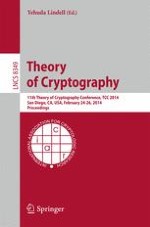2014 | OriginalPaper | Buchkapitel
Obfuscation for Evasive Functions
verfasst von : Boaz Barak, Nir Bitansky, Ran Canetti, Yael Tauman Kalai, Omer Paneth, Amit Sahai
Erschienen in: Theory of Cryptography
Verlag: Springer Berlin Heidelberg
Aktivieren Sie unsere intelligente Suche, um passende Fachinhalte oder Patente zu finden.
Wählen Sie Textabschnitte aus um mit Künstlicher Intelligenz passenden Patente zu finden. powered by
Markieren Sie Textabschnitte, um KI-gestützt weitere passende Inhalte zu finden. powered by
An
evasive circuit family
is a collection of circuits
$\mathcal{C}$
such that for every input
x
, a random circuit from
$\mathcal{C}$
outputs 0 on
x
with overwhelming probability. We provide a combination of definitional, constructive, and impossibility results regarding obfuscation for evasive functions:
1
The (average case variants of the) notions of
virtual black box
obfuscation (Barak et al, CRYPTO ’01) and
virtual gray box
obfuscation (Bitansky and Canetti, CRYPTO ’10) coincide for evasive function families. We also define the notion of
input-hiding
obfuscation for evasive function families, stipulating that for a random
$C \in{\mathcal{C}}$
it is hard to find, given
$\mathcal{O}(C)$
, a value outside the preimage of 0. Interestingly, this natural definition, also motivated by applications, is likely not implied by the seemingly stronger notion of average-case virtual black-box obfuscation.
2
If there exist average-case virtual gray box obfuscators for all evasive function families, then there exist (quantitatively weaker) average-case virtual gray obfuscators for
all
function families.
3
There does not exist a
worst-case
virtual black box obfuscator even for evasive circuits, nor is there an average-case virtual gray box obfuscator for evasive
Turing machine
families.
4
Let
$\mathcal{C}$
be an evasive circuit family consisting of functions that test if a low-degree polynomial (represented by an efficient arithmetic circuit) evaluates to zero modulo some large prime
p
. Then under a natural analog of the discrete logarithm assumption in a group supporting multilinear maps, there exists an input-hiding obfuscator for
$\mathcal{C}$
. Under a new
perfectly-hiding multilinear encoding
assumption, there is an average-case virtual black box obfuscator for the family
$\mathcal{C}$
.
